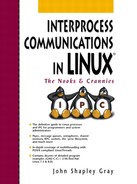
The topic of interprocess communication techniques is broad, challenging and dynamic. All but the most basic operating systems provide methods for processes communication. Early on, UNIX supported a number of rudimentary process communication constructs (such as lock files, signals and pipes). In the early 1980s, facilities such as message queues, semaphores, and shared memory were added to the mix by AT&T with its release of UNIX System V. Somewhat concurrently, the Berkeley Software Distribution added support for Internet protocols (4.3BSD) and the socket interface as a communication construct. By the mid-1990s, threads and multithreaded programming techniques were making significant, permanent inroads into the UNIX mainstream.
Along the way, UNIX spawned innumerable UNIX-like operating systems. One such operating system was MINIX. MINIX, written by Andrew S. Tanenbaum, is a small (about twelve thousand lines) PC version of UNIX. MINIX was presented as a pedagogical tool to permit the user to gain a better understanding of the inner working of a UNIX-like operating system. As all of the operating system source code was provided, the user could tinker with the code and refine its functionality. As a university student, Linus Torvalds' exposure to MINIX led him to develop a more robust UNIX-like operating system called Linux. In brief, Linux is a freely distributed hybrid version of UNIX. Linux system administration is BSD-like while its programming environment has a definite AT&T flavor. A number of commercial versions of Linux populate the market. These versions bundle Linux with a variety of other operating system related utilities and software packages. One of the more widely distributed commercial versions is Red Hat Linux. Red Hat Linux includes Richard Stallman's GNU project C (gcc) and C++ (g++) compilers.
This text explores the intricacies of interprocess communications as supported by Red Hat Linux version 7.3 and 8.0. It is assumed that the reader has a working knowledge of C/C++ programming. It is further assumed that while not being an expert, the reader has worked in a UNIX type environment and is reasonably familiar with generating and editing text using an editor such as vi or pico (available from the University of Washington). This text makes extensive references to specific system calls and predefined library functions. The reader is encouraged to read the manual pages for each system call/library function as it is encountered. As in UNIX, the manual pages in Linux are an unparalleled source of information. Appendix A covers the format and use of manual pages.
All programming references and examples were generated on a PC Pentium-based platform running Red Hat Linux 7.3, using the GNU C/C++ compiler version 2.96. With the release of Red Hat Linux 8.0 and GNU 3.2 the examples were revisited and tweaked where necessary. Many of the examples and most of the exercises have also been compiled and run in a Solaris 2.8 setting using GNU 2.95. Most often, few if any modifications were needed to generate clean, executable code in this alternate environment.
Each example is a complete standalone program. Command line examples, except where noted, are Korn shell based. In any setting, IPC (interprocess communication) support must be available for the user to pursue the materials covered in the chapters on semaphores, message queues, and shared memory. When Linux is installed, usually IPC support is enabled (check the /proc directory for the presence of the sysvipc directory). If it is not present you may need to modify system configuration files and recompile the kernel. There are a number of places that one can peruse for information on how this might be done. One source of information is the Configure.help file that resides in the /usr/src/linuxXXXX/Documentation subdirectory (where XXXX is the version of Linux). A second source is the URL http://www.tldp.org/docs.html. However, unless you are the system administrator, you most likely will want to seek help when doing this. To work with threads, a POSIX compliant thread library (such as LinuxThreads) must be available. Fortunately, most new versions of Linux come with thread libraries that are distributed with the GNU compiler (check the /usr/lib directory for files names containing pthread, e.g., libpthread.a or libpthread.so). The URL http://sources.redhat.com/glibc/ provides a web page with additional information on glibc the GNU libc program.
Works of any complexity are never completely finished. Your comments, suggestions, corrections, and exercise solutions are welcome. I can be contacted at [email protected]. Program examples can be obtained at www.phptr.com/gray.
